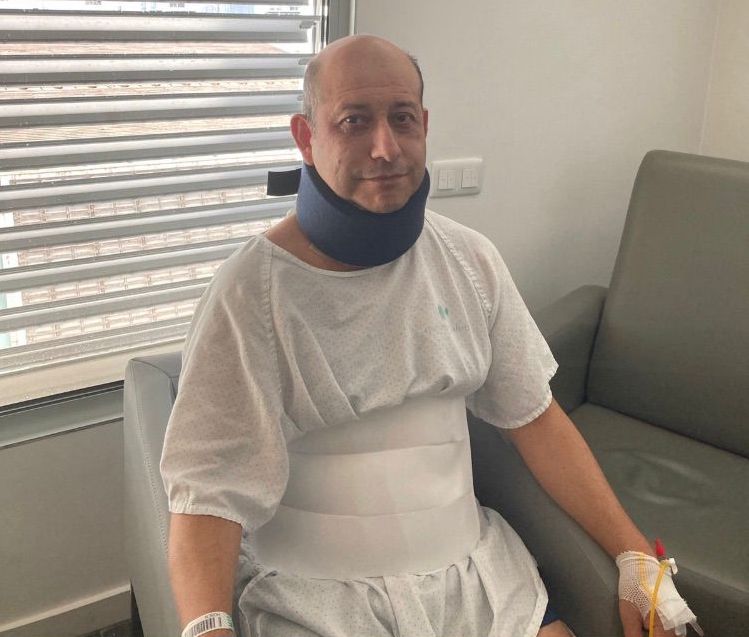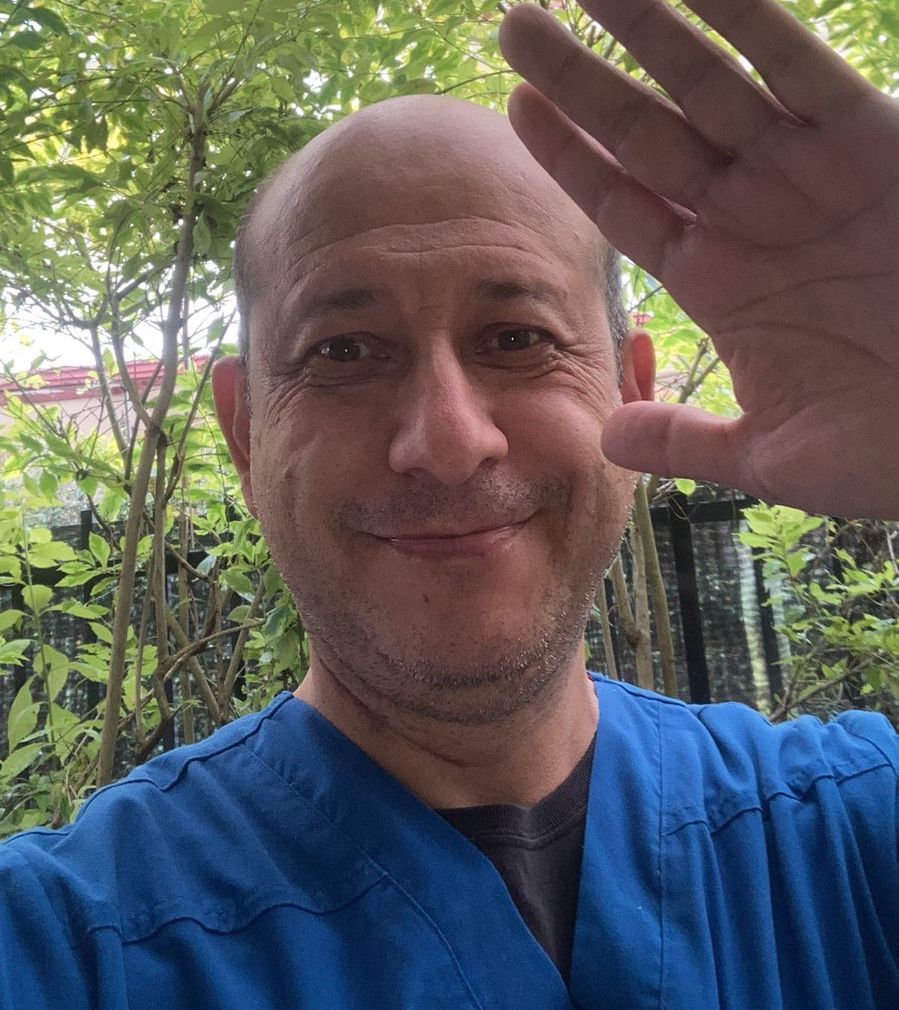Edgar Rojas, a 54-year-old Colombian radiologist, discovered Instituto Clavel on YouTube, by watching the video testimonial of another patient who underwent disc replacement surgery (ADR) last year. He decided to place his trust in us for treatment of his hernias, and in the following interview you can read what he says about his experience here.
"I had been suffering from pain in both my right buttock and right leg for quite some time, due to an L4-L5 lumbar disc herniation, and then later, I had paresthesia in my arms from a C5-C6 cervical disc herniation."
After receiving the diagnosis, he started looking into treatment options in Colombia. Being a doctor, he contacted several surgeons, but after researching the possibilities, none of them offered the option of having an anterior approach disc replacement surgery, and he was concerned about the possibility of postoperative complications and even losing mobility.
It was then that he discovered Instituto Clavel, and after seeing the testimony of Santiago Esteve and other patients on YouTube, he decided to contact us. In the following, Edgar tells us about his expierence in his own words.
How did the symptoms affect you on a day-to-day basis?
The lumbar hernia was two years ago, but it was misdiagnosed since the pain was atypical, in the buttock, and not radicular pain. My quality of life was poor during those two years because it limited my ability to do physical activities. My kids are still young and I couldn't play with them.
When they detected the hernia I started using crutches. They gave me infiltrations, and with the use of the crutches I began to notice pain and numbness in my arms. I got worried, had an MRI, and they found the other hernia. So, of course, my quality of life was depressing, because, being a doctor myself, I knew the natural progression of the disease. I knew it was going to get worse. So I was quite affected emotionally and professionally, I had to limit the number of patients I attended.
Why did you decide to contact us?
It was as a result of those posts, the videos of patients and the explanation given by a doctor [referring to Dr. Baños]. I am a radiologist. I see spinal MRIs every day, and I knew about herniated discs, until it happened to me. I started investigating, and in Latin America there was no one that inspired my trust.
I arrived at Dr. Clavel and listening to him gave me peace of mind. I also looked up academic and scientific articles, for more information. This gave me even more confidence and I asked for an appointment. This is how the process of reaching out from my country began.
Living in Colombia, you had your first evaluation appointment online. How was it?
It was great. It answered a lot of my questions about the surgery, even though I more or less knew about it. He cleared up a lot of things, and at first, he proposed the option of doing a posterior approach to the spine, which I told him I was afraid of because, even if it was microsurgery, the healing process and recovery would be more complex.
So I asked if it would be feasible to do the surgery by anterior approach and he said yes, it was the other viable option. So we settled on that.
That’s when you began planning the trip here. How did you feel about that?
It was not an easy decision to make. Many colleagues and family members tell me that I was very brave. I don't know if that’s true, but I did it out of necessity. The flight from Colombia to Spain is 10 hours long, and I had to take medication for the pain.
They recommended that I stay in Spain for at least 10 days; we stayed 12. Those 2 extra days helped me a lot, and the return trip, despite having just had surgery, was much better than the one coming over; the pain was minimal.
When you arrived in Spain, what was your impression of the hospital and the team?
Spectacular. I work in well-known top level hospitals, and at Instituto Clavel I felt very comfortable. I received VIP treatment and the first impression met my expectations, made me feel sure that I was in the right place.
And what do you remember about the day of surgery?
When the moment came that I was actually getting ready for surgery, I felt afraid. Because before that, when we were planning the surgery, it was talking to the interdisciplinary medical team, but when I was left alone on the stretcher, I felt panicked. I told the anesthesiologist "look, please give me something because I'm so nervous." The next thing I remember after that was getting up, back in my hospital room.
I was in some discomfort, but even though I had just had surgery, and although it sounds ironic, I felt at ease, because I felt that the worst was over. It is in those moments that you need the support of other people, the smallest detail counts, and I feel that I had that at all times. Before, during, and after surgery.

You mentioned that your wife accompanied you. What was the experience like for her?
I had gone to Barcelona to study (at the Fundación Puigvert), 12 years ago, and at that time my wife could not travel, which left her still wanting to visit Europe. Now, with my health situation, she saw the opportunity to travel and it was an additional motivation.
Obviously, you have to consider that the trip was for an operation and that taking care of a sick person is not easy, but let's say that everything worked out and she was delighted with the city and the way we were treated.
After the surgery you had several rehabilitation sessions. What was that like?
The first day I had a hard time walking and it was difficult despite being very close to the rehabilitation center, but Laia, the physiotherapist, made me feel very good. She turned out to be highly skilled, with a true human touch, managing everything with great professionalism from the start.
She found the right balance. Because in the first sessions you don’t want anyone to touch you, she understood how to manage my pain and anxiety, making me feel comfortable while she worked. I felt that each day was better than the one before. So much so, that I made a real effort, and she congratulated me saying that many patients do not reach the stretching capacity that I reached on the second day.
It was a very pleasurable experience, and we actually stayed two more days to continue the therapy.
It's been a few months since the surgery. How do you feel now?
The surgery was on February 23rd, and yes, my life has certainly improved. My friends and my wife tell me that even my overall appearance has changed. I'm still young, I have a productive life, kids to raise and it had been very depressing to feel limited and to think that I could get worse.
My state of mind has improved. I have always been a very cheerful person, with a sense of humor, and I feel like myself again. Regarding the physical part, I’m back to leading a normal life. I do not take medication. Occasionally, I feel some discomfort in the leg, but that’s normal, because I had the hernia for two years, and that led to some atrophy.
Overall, the change has been spectacular. Even my own fellow doctors say to me: You had surgery for two hernias in your spine and you’re already walking? But how? Because I was already abackt work after three weeks and it seemed impossible. But yes, recovery is definitely very hard with traditional surgery, but not with this technique.
And do you have to take any precautions?
Yes, but in the sense of taking care of myself. I protect myself, avoid some unnecessary movements and excess effort, and when I know I am going to walk more than usual, I wear a lumbar support.
I take very good care of the surgical incisions, which are going through their natural process of healing.
Lastly, what would be your overall assessment of the experience from your point of view as both a doctor and a patient?
As a patient, I felt special, and that’s great, because you're going through a hard time. You are grateful to be there.
As a doctor, I felt that there was a clear focus from the start. Dr. Clavel, as I say, proposed one type of approach, but he had no problem changing it. He is flexible as long as (what is proposed) can be carried out, and in medicine, this is necessary. In the end you have to have an approval and share what you think is good for the patient, to see what he thinks.
Finally, you, as a patient, are going to end up accepting what the specialist says, but he gives you that option. I really liked that. And also the way you are accompanied by the nurses, the visits from the doctors and physical therapists in the hospital. You felt accompanied every day. It was great.
Look, I know it may sound absurd, but if I had hernia symptoms again, I wouldn't hesitate to go again, I would repeat it. I know I’m not talking about a walk around the block, I know there is a cost, but because it was so successful, I would do it again.

So, if you know someone who is going through a similar situation, would you recommend Instituto Clavel?
In fact, I made a video telling all about my experience for my college graduate colleagues. As I said, I have always been a very cheerful person, the one who organizes events and meetings at the university. I used what happened to me to do the same thing.
I even explained it to a colleague who is a very close friend. He’s an orthopedic surgeon who has been dedicated to spine surgery for years, and he was one of the doctors who told me that the surgery he would perform on me himself would be by posterior approach. Whenever I can, I tell my relatives, other people, my patients, that there are other alternatives, and that I do not understand why other specialists have not yet been trained in Colombia in this surgical technique.
Only people who have suffered from a hernia know what it is like. You can hear about it a thousand times, but you only realize how serious it is when you feel it yourself, and then you appreciate the value of having these alternatives.
Categories: Spine treatments, Surgery, Testimonials
